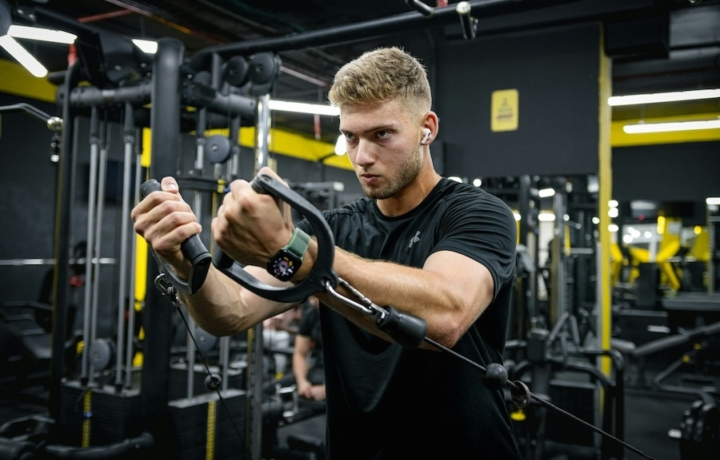Exercise
Incline Dumbbell Fly

Incline Dumbbell Fly
How to Perform
- Set an adjustable bench to a 30–45 degree angle and sit with a dumbbell in each hand resting on your thighs.
- Lie back on the bench and use your thighs to help kick the weights up, positioning the dumbbells at arm's length above your chest with palms facing each other.
- Slightly bend your elbows to reduce stress on the joints and maintain this angle throughout the movement.
- Brace your core and press your lower back into the bench to maintain a stable position.
- Inhale and slowly lower the weights in a wide arc until you feel a stretch across your chest, keeping your elbows fixed at the same angle.
- Lower the weights until your elbows reach approximately shoulder height, without allowing the dumbbells to drop below the level of your body.
- Exhale and contract your chest muscles to bring the dumbbells back up in the same arc motion, maintaining the slight bend in your elbows.
- At the top position, squeeze your chest muscles briefly before beginning the next repetition, keeping your shoulders down and away from your ears.
Important information
- Select a weight that allows you to maintain proper form throughout the entire set — this exercise is about controlled movement, not maximum weight.
- Keep your feet flat on the floor and your head against the bench to maintain stability throughout the exercise.
- Avoid flaring your elbows too far out to the sides, which can place unnecessary stress on your shoulder joints.
- If you feel any shoulder pain, decrease the range of motion or switch to a less demanding chest exercise.

Incline Dumbbell Fly
Exercise Details
Primary Muscles
Muscle Groups
Mechanic
Risk Areas
Built for progress
Take the guesswork out of training
Create personalized AI-powered workout plans that evolve with you. Train smarter, track every rep and keep moving forward, one workout at a time.






The Incline Dumbbell Fly stands as a cornerstone chest exercise in the arsenal of intermediate-level fitness enthusiasts looking to sculpt defined pecs and strengthen their front deltoids. This movement has earned its reputation in bodybuilding circles for its ability to effectively isolate the chest muscles while creating that aesthetic stretch and contraction that builds noticeable muscle separation. Unlike compound chest movements that engage multiple muscle groups simultaneously, the Incline Dumbbell Fly targets the upper portion of the pectoralis major with remarkable precision, giving you that shelf-like upper chest development that's often difficult to achieve with flat pressing movements alone. The angled position on the incline bench shifts emphasis toward the clavicular head of the pecs while recruiting the anterior deltoids as secondary movers, creating balanced development across the upper body's pushing muscles.
For those focused on strength goals, don't underestimate this exercise despite its reputation as primarily a bodybuilding movement. When performed with appropriate resistance and proper form, Incline Dumbbell Flys strengthen crucial stabilizing muscles around the shoulder joint, potentially improving your performance on heavier pressing movements while reducing injury risk. The controlled nature of this exercise allows for developing strength through a full range of motion, particularly at the stretched position where many lifters are weakest.
Many bodybuilders incorporate this exercise later in their chest workout after heavier compound movements have fatigued the larger muscle groups. This strategic placement allows for deeper muscle fiber recruitment when the pecs are already partially exhausted. For maximum effectiveness, consider moderate rep ranges of 8-12 repetitions with a weight that challenges you while maintaining proper form throughout the movement. Whether your goals lean more toward competitive bodybuilding aesthetics or functional strength development, the Incline Dumbbell Fly deserves a place in your routine if you're serious about developing a powerful, well-defined upper chest that commands attention.
FAQ - Incline Dumbbell Fly
The Incline Dumbbell Fly primarily targets the upper portion of the pectoralis major (upper chest), with secondary activation of the anterior deltoids (front shoulders) and serratus anterior. The incline angle shifts emphasis to the clavicular head of the pecs, creating that shelf-like upper chest development.
Set an incline bench to 30-45 degrees and hold dumbbells directly above your chest with palms facing each other. Lower the weights in an arc motion until you feel a stretch in your chest, keeping a slight bend in your elbows throughout. Contract your chest muscles to bring the dumbbells back up in the same arc path without letting them touch at the top.
The most common mistakes include using too much weight (causing excessive shoulder strain), flattening the bench too much (reducing upper chest activation), straightening the arms completely (placing stress on elbow joints), and bouncing the weights at the bottom of the movement. Maintain controlled motion throughout and focus on the chest stretch rather than the weight used.
For an easier variation, use lighter weights, reduce the incline angle slightly, or decrease your range of motion until strength develops. To increase difficulty, use heavier dumbbells, slow down your tempo (especially during the lowering phase), increase the incline angle up to 45 degrees, or add a brief pause at the bottom position when your chest is fully stretched.
Include Incline Dumbbell Flys 1-2 times weekly as part of your chest training, typically performing 3-4 sets of 8-12 repetitions. Position this exercise after your compound pressing movements when training for hypertrophy to pre-exhaust the larger muscle groups and maximize muscle fiber recruitment in the upper chest region.







